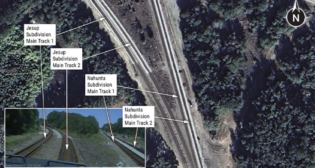
Rethinking railroad safety and efficiency
Written by Douglas John BowenAn innovative project on Egyptian National Railways is an example of how small railroads can install PTC at a low cost.
Over the past decade I have taught Railroad Immersion and PTC courses to railroads, traditional signaling suppliers, and suppliers who are considering the railroad market with their products and services. Interestingly, while the new folks without any history with electronic signaling readily accept two primary issues presented in the course, the railroaders and traditional suppliers argue long and hard before their acceptance.
Specifically, I state that 1) signals are not installed for safety, and 2) CTC is not a traffic management system. For railroaders and traditional suppliers, these two points when introduced are seemingly heretic statements, since signaling and CTC have been a part of railroad operations since the beginning of the 20th century. Yet one-third of the freight rail trackage in the U.S. operates safely without signaling, and one-half operates with significant capacity without CTC.
What gives? Railroaders and signal suppliers who have been nurtured on electronic signaling infrastructure associate the concept of railroad vitality, i.e., the integrity of train movements, with that of equipment, instead of the functionality that traffic control is used to ensure the integrity of train movements. The former perspective of equipment vitality is that of having the infrastructure responsible for generating movement authorities to be failsafe so as a false proceed is not provided when those systems fail to operate.
But the true issue of any traffic control system, whether it be signaled, non-signaled, or even the antiquated token block systems stemming from the British railroads in the mid-19th century, is to provide functional vitality to ensure that overlapping authorities are not generated, whether they are working or not working properly—keeping in mind that GCOR (General Code of Operating Rules) or NORAC (Northeast Operating Rules Advisory Committee, in the Northeast) is the threshold of functional vitality when any traffic control system goes south. If this is understood, then consider non-signaled operations—dark territory—that uses an extremely simple conflict checker, whether it be a train sheet or a computerized version widely deployed in the U.S.
During a course I often ask, “What is vital in dark territory?” The response is “nothing,” with students thinking of the concept from only a lack of signaling infrastructure in those operations, thereby lacking equipment vitality. They don’t think of the functional perspective of preventing overlapping authorities. The functional vitality of dark territory resides in the conflict checker, and then the rulebook.
For major railroads that need signaling systems to provide capacity (the actual reason for signals, albeit in a safe way), this is a moot point in that there is no choice short of moving-block (the ultimate dark territory). Many railroads don’t need the capacity of signaling systems. But most of these railroads are not being presented with pragmatic, cost-effective traffic control systems that are safe, and provide sufficient capacity that minimize the financial risk for improving or initiating rail services that are critical to their profitability, and outside of the U.S. for expanding their country’s commerce. A recent study that my consultancy completed for the Egyptian National Railroads (ENR) addresses not only traffic control, but also traffic management and enforcement such as Positive Train Control (PTC).
ENR is a 3,100-mile operation that consists of 82% token block, and 18% CTC. This is a railroad with 500 mechanical interlockings and 1,000 level crossings with guards to provide protection for the public. ENR has been plagued with deadly train accidents, including two in November 2012 due to errors by individuals that PTC, or any other current enforcement system, could not have prevented. For ENR we designed a Virtual CTC (VCTC) system that integrates proven traffic control and traffic management with the expanded functionality of PTC.
The design of VCTC is based upon an integration of traffic control, traffic management, and safety enforcement. The approaches used by VCTC for each of these systems are well established in the U.S., but they have not been integrated and expanded in functionality in the fashion designed for ENR that uses the locomotive as a mobile node to the back office traffic control and management systems.
For traffic control, VCTC uses an advanced version of TWS (Track Warrant System). By using the locomotive as a mobile node, the onboard VCTC platform continuously provides position of the train to a computerized conflict checker to dynamically update the status of track segment occupancy automatically without the involvement of the train driver and dispatcher. The method of determining the position of the train, including which track the train is on, is by means of routing logic linked with a track database and a Kalman Filter that can integrate a variety of possible inputs, including GPS, GLONASS (Global Navigation Satellite Systems), locomotive tachometer, discrete wayside detectors, and track circuits. Additionally, once the computerized conflict checker in the dispatching office has approved the assignment of the track segment to a train based upon the dispatcher’s request to generate a movement authority, the information is automatically sent to the onboard platform via wireless data for presentation on the driver’s display. These digital authorities replace the time-consuming transmit-and-repeat approach required for the current use of voice communications to ensure the transmission integrity of the movement authority.
As to traffic management, the lack of timely train speed and position data can limit the capacity of railroads as to track time and the key operating assets, given that the majority of railroads are truly unscheduled and therefore subject to the inefficiency of conflicts of opposing or following trains using the same track. CTC only displays the status of track blocks at some point in time, without any speed data such as the train coming to a stop, and therefore is highly inefficient in supporting even the most experienced dispatcher’s efforts to manage the movement of trains across his/her territory.
VCTC expands upon the functionality of CTC by using the locomotive as a mobile node to continuously update train position and speed data. Those data are used by mathematics-based meet/pass planners to continuously project traffic movement conflicts and make recommendations to the dispatcher to minimize the consequences of such conflicts, what I refer to as proactive traffic management. This approach, vs. the reactive, crisis-based approach of CTC, can be truly effective in increasing the capacity for scheduled as well as unscheduled operations.
For safety enforcement, in designing VCTC we expanded upon the four enforcement objectives of PTC: 1) Prevent an over-speed condition. 2) Prevent the train from endangering work zones. 3) Prevent a train from exceeding its movement authority, and 4) Prevent the train from moving through a misaligned switch. Specifically, we designed VCTC to protect against errors by “vital employees” who also create authorities—mechanical interlocking operators, work gang supervisors, and level crossing guards.
The reality of our analysis for ENR was soon demonstrated by two train accidents on that railroad in November 2012, resulting in 55 fatalities, due an error by a mechanical interlocking operator for one case and a level crossing guard for the other.
My presentation of VCTC several weeks following those accidents to the officials of ENR and the Egyptian Ministry of Transport was well accepted, with Egypt’s prime minister directing ENR to move forward with a testing of VCTC.



